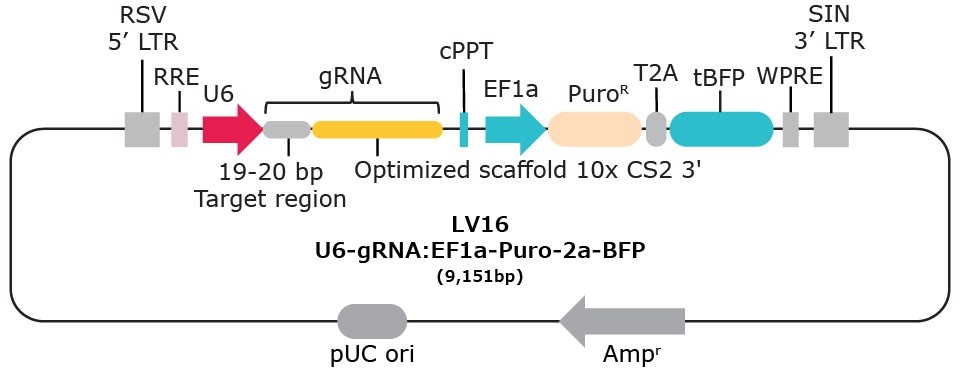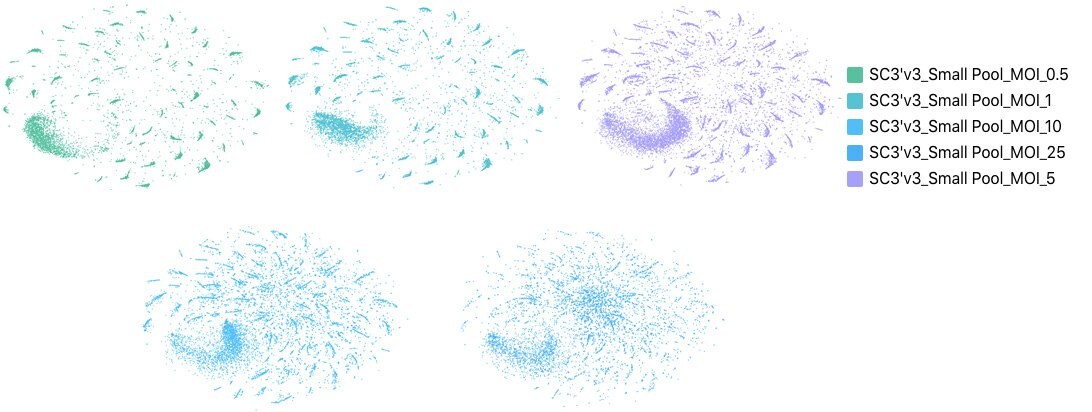Discovery at Single-Cell Resolution
Pooled CRISPR Screening with 10x Genomics Compatibility
CRISPR lentiviral products are powerful research tools for the discovery of novel genes and cellular pathways essential to understanding human health and disease. As a world leader in the production of lentiviral libraries, we design and build custom pools to any specifications. With this capability, we have partnered with 10x Genomics to bring innovative pooled screening products to enable discovery at single-cell resolution
CRISPR-based functional genomics screening provides a broad overview of the genetic contributions to a measurable phenotype. Bulk screening, however, only provides limited functional information beyond the selectable phenotype. At the other end of the spectrum, single-cell analysis provides high content information centered around genome-wide transcriptome profiling for candidate genes. We offer optimized, customized lentiviral vectors compatible with Chromium Single Cell Gene Expression v3 and v3.1 (Next GEM) solution utilizing Feature Barcode technology.
Getting Started with 10x Single Cell Compatible Products: |
|---|
Recommendations
- Consider doing a pilot study using our optimization kit and/or individual clones
- For small pool screening, we recommend 100-200 cells for each targeting guide and
500-1000 cells that contain a non-targeting guide. - Use 2-5 gRNAs per gene target
Vector options with 10x single cell compatibility:





Capture Sequence Integration

Figure 1.CRISPRi Feature Barcode technology Optimization Kit
This kit includes pooled virus representing each of the 2 possible capture sequences and 2 position combinations (capture sequences 1 or 2, in the stem-loop or 3′ position). Present within each pool are 2 CRISPRi sgRNAs, 1 targeting RAB1A and 1 non-targeting control sgRNA. Each pool is provided ready to use at 1x10^6 viral titer, sufficient enough to cover ~2x10^6 cells at an MOI of 0.5. The purpose of the optimization kit is to set up a pilot screen to determine the best capture sequence and position configuration before a custom pool is ordered.
10x Compatible products for Feature Barcode technology (gRNA)

Figure 2.We recommend creating custom pools so that when running the 10x Single Cell CRISPR assay, 100-200 cells are recovered for each targeting guide and 500-1000 cells are recovered that contain a non-targeting guide. For example, a user that wishes to target 10,000 cells recovered, we recommend that 10% of the guide pool is made up of non-targeting guide(s), while the remaining 90% is targeting guides. For the targeting guides in this example we would recommend that each targeting guide represent >=2% of the overall guide pool. The more cells that are run, the smaller the percentage of the pool is needed to be non-targeting guide(s).
Tracking gene perturbations at single cell resolution
Knockdown efficiences: log2 fold change vs p-value

Figure 3.Results from a small test CRISPRi pool showing the knockdown efficiency of each guide on its target gene through fold change in expression versus normal levels. Non-targeting guides as well as those with lower knockdown sit in the bottom right quadrant while those exhibiting stronger and statistically significant repression are located in the top left. Because of cell line variation and gRNA efficiency it’s important to target with multiple gRNAs per gene basis, we recommend 3-5 per gene.
Monitoring multiple viral transductions at single cell resolution
Clustering - CRISPR Guides
Higher MOI samples show less distinct clustering due to multiple infections.

Figure 4.The same small pool, shown in Figure 3, was tested using a range of MOIs (from 0.5 to 50, 0.5-25 shown). Unlike bulk screening, single-cell resolution is highly sensitive and can pick up multiple viral infections at the single-cell level. Results demonstrate the ability of the 10x assay to detect numerous infections based on the number and distinctness of clusters in the Loupe Cell Browser. The more infections, the less distinct individual cells are from each other. The power of single-cell resolution allows you to track and filter this data. Based on these results, we recommend MOIs of 0.5 to 1 for maximum resolution.
Single cell clustering by GEX and gRNA

Figure 5.Pooled screening is a powerful approach that easily characterizes phenotypes based on growth- perfect for whole-genome screening. Our optimized lentiviral vectors and pools allow tracking of both gene expression and gene perturbation in the same assay. Monitoring both allows for comprehensive molecular characterization at single-cell resolution, which has not been achievable in the past. Researchers will be able to hone in on candidate genes at a single-cell resolution for functional characterization — Left: Clustering based on gene expression (GEX). Sub-clusters colored based on graph-based clustering. Middle: Clustering based on CRISPR gRNAs. Highlighted expression of one gRNA. Right: One example of gRNA expression shown in clustering based on gene expression.
Request Information
See our viral transduction page for protocols:
For more information on Feature Barcode technology and Analysis:
For more information see:
References
続きを確認するには、ログインするか、新規登録が必要です。
アカウントをお持ちではありませんか?